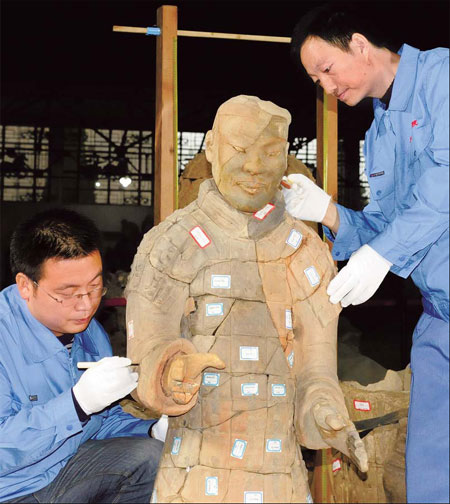3-D jigsaw puzzle assembles ancient army
More than 2,200 years after the Terracotta Warriors were created to serve the first emperor of feudal China, they now have their own servants - a team of around 30 scientists who restore, repair and beautify them with modern tools and technology.
"When these pottery statues were unearthed, they were mostly in small pieces," said Wang Liang, a scientist at the preservation and storage department of the Museum of the Terracotta Warriors and Horses of Qin Shihuang.
"What we do is to bring them back to life," Wang said.
Since sculptures depicting the armies of Emperor Qin Shihuang were discovered in 1974 by farmers in Xi'an, Shaanxi province, the museum has restored about 1,200 Terracotta Warriors and Horses which are now on display in Xi'an, as well as on loan to other Chinese cities.

Ten more have been repaired this year, while an uncertain number remain buried.
Wang said the most difficult job is to preserve and restore the color of a Terracotta Warrior.
"These warriors wear black armor and red straps, and their clothes have various colors - purple, blue, green and yellow," Wang said.
But a large number of unearthed warriors have lost most of their color. At best, some purple remains on their long sleeves, pied yellow on their faces, and a bit of red on their lips.
"After exposure to the air for five to 10 minutes, the paint will crack, curl and peel off," Wang said.
This is because the chemicals in the paint have been preserved in an underground environment for thousands of years with high humidity and little air. So when the relics are brought back to the surface, the paint reacts with the air, said Zhou Tie, chief engineer of the museum.
To keep the remaining color on the sculptures, scientists apply a moisturizer to the surfaces immediately after pieces are unearthed, and then add consolidation agents.
The moisturizer, called PEG200, is commonly used to produce cosmetics. Wang said it is imported from Germany because China has not been able to produce the moisturizer up to the standards required by the museum.
Since 1991, the museum has cooperated with German institutions, including the Technical University of Munich, on various projects and personnel exchanges.
One of the rewards from the job of restoring the Terracotta Warriors is that scientists acquire a knowledge of ancient craftsmanship.
For example, lab tests show that a compound of pigment was applied on a layer of lacquer when the warriors were painted.
Craftsmen of the Qin Dynasty (221-206 BC) used the lacquer to smooth the crude surface of the pottery. If not, they would require more pigment, which was expensive at that time, Wang said.
Usually, one or two warriors are unearthed at a time - in small pieces.
Before the pieces can be put together for restoration, they will undergo a series of lab tests to see at what temperature they were fired and how many layers of paint and pigment were applied, said Yan Sumei, a senior engineer of the museum.
Restoring a warrior usually takes three people 60 to 90 days.
Sometimes, they check whether the statues are free from bacteria that can crack their surfaces.
If a hazardous microorganism is detected, scientists will use chemical agents to kill it before sending the relics to a designated storage place, Yan said.
The most boring part of the restoration is piecing them together.
"It is a time-consuming game of jigsaw," Wang said. "It has to be done manually."
"Standing warriors are harder to fix than kneeling ones, because standing warriors' centers of gravity are higher and they broke into more pieces when they fell," Wang said.
Scientists have tried to use three-dimensional computer images to help, but the technology turned out to be unhelpful because matching hundreds of irregular pieces was beyond the capability of regular computer programs.
"In this regard, a professional's expertise works better than computers," Wang said.
(Source: China Daily)

